�
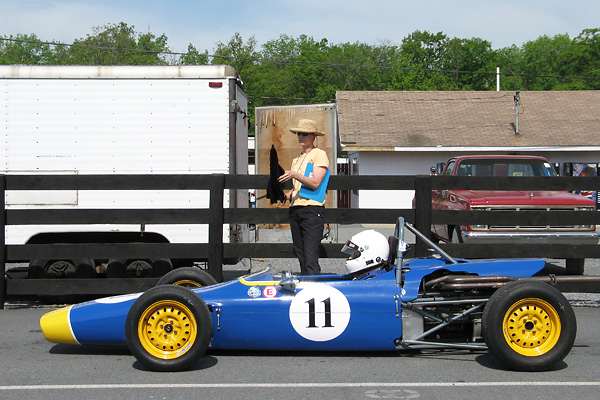
�
Bernard Bradpiece's 1969 Merlyn 11A Formula Ford Racecar
� � Owner: Bernard Bradpiece� City: Annapolis Maryland
� Model: 1969 Merlyn MkVII
� Engine: 1600cc Ford Kent four cylinder
� Restored and race prepared by: Lee Chapman Racing �
�
Bernard Bradpiece's Experiences With His Merlyn 11A
��
Bernard Bradpiece acquired this Merlyn 11A in 1986 from a previous owner in Northern Ireland who racad it�
in hillclimb competitions. Living in England at that time, Bradpiece arranged to have the car rebuilt by�
Mark Dunham Race Engineering in the UK, and he had the engine rebuilt by Scholar. Then, he raced it with�
increasing success in pre-1974 Formula Ford. He also campaigned it in the first year of the Historic�
Sports Car Club's (HSCC's) Vintage Formula Ford program, where he won the pre-1970 class.�
�
Bradpiece brought his Merlyn 11A to the United States in 1995, and ran two race meetings before putting�
it up on blocks and storing it for nine years. In 2005 Bradpiece hired Lee Chapman Racing to coordinate a�
second extensive restoration. Pat Prince (Prince Racecar Engineering) restored the chassis and MWE�
(Marcovicci-Wenz Engineering) rebuilt the engine.�
�
Since the second rebuild, Bradpiece has competed in sixteen race weekends. This vintage Formula Ford has proven�
to be one of the quickest in the mid-Atlantic region with two wins at V.I.R.'s Gold Cup, wins at Watkins�
Glen, and at the Jefferson 500 at Summit Point (where we photographed it). When it hasn't won, the car has �
always placed and usually gets fastest lap for its class.�
�
 �
�
�
�
Features and Specifications
�| Engine: | �1.6L Ford four-cylinder engine, fully prepped for 2010 with a $5000 refresh by Ted Wenz�
(including a replacement 711M6015BA engine block).�
Weber 32/36 DGV carburetor.�
Original period SchoLar air inlet.�
Bosch distributor.�
Hotwires 8mm silicone high performance suppressed spark plug wires.�
Bosch blue ignition coil.�
Dry sump lubrication system.�
Race Parts oil pump cover.�
Fram Racing oil filter. | �
| Cooling: | �copper/brass radiator.�
Engine coolant is plumbed through the frame.�
Custom fabricated aluminum swirl pot.�
Setrab 13-row oil cooler (part# 50 613 7612). | �
| Exhaust: | �four into one stainless steel header. | �
| Transaxle: | �Mk8 Hewland with doughnuts, rebuilt in 2010 by Lee Chapman within a new Rhino gearbox case.�
F3 clutch. | �
| Front Susp.: | �unequal length wide-based wishbones (new at restoration).�
Triumph (Alford & Alder, forged) uprights.�
New Leda shocks (Armstrong replicas).�
Hyperco springs.�
Adjustable anti-sway bar. | �
| Rear Susp.: | �inverted lower wishbones, single top links, and twin adjustable trailing links.�
Proprietary Merlyn magnesium uprights.�
New Leda shocks (Armstrong replicas).�
Adjustable anti-sway bar. | �
| Brakes: | �(master) dual Girling master cylinders with remotely adjustable bias bar, � (front) Girling 14LF calipers. Brembo rotors. Hawk "blue" pads, � (rear) Girling 12SP calipers. Brembo rotors. Hawk "blue" pads. | �
| Wheels/Tires: | �early Weller type steel wheels. Dunlop Racing "Formula Ford" tires (135/545-13 CR82 front, 165/580-13 CR82 rear). | �
| Electrical: | �Enersys Powersafe SBS sealed battery.�
Gear reduction starter. | �
| Instruments: | �(left to right)�
Racetech oil temperature (40-140C) gauge. �
Racetech oil pressure (0-160psi) gauge. �
original Smiths chronometric tach (0-10,000rpm) freshly rebuilt by Nisonger.�
Racetech coolant temperature (30-110C) gauge. | �
| Fuel System: | �ATL fuel cell with new foam in mid 2009. | �
| Safety Eqmt: | �Willans six point Cam-loc safety harness (expires end of 2014).�
S.P.A. Fire Fighter centralized fire suppression system. | �
| Body: | �still presented in the original gelcoat!�
Wingard mirrors. | �
| Weight: | �1088 pounds with driver: 214# left and right front, 325# left rear, 332# right rear. | �
| Performance: | �2m 12.4s at VIR, 2m 12.3s at Watkins Glen, and 1m 22.7s lap times at Summit Point. | �
| Racing Class: | �vintage Formula Ford | �
Engine Installation
��
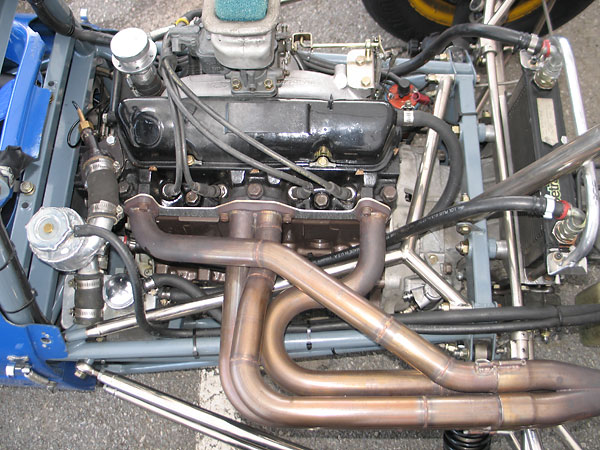
�
1.6L Ford four-cylinder engine, fully refreshed for 2010.
�
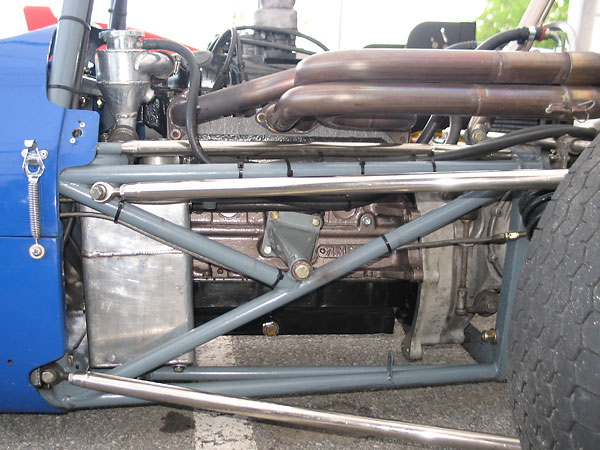
�
The engine was race prepared by Marcovicci-Wenz Engineering.
�
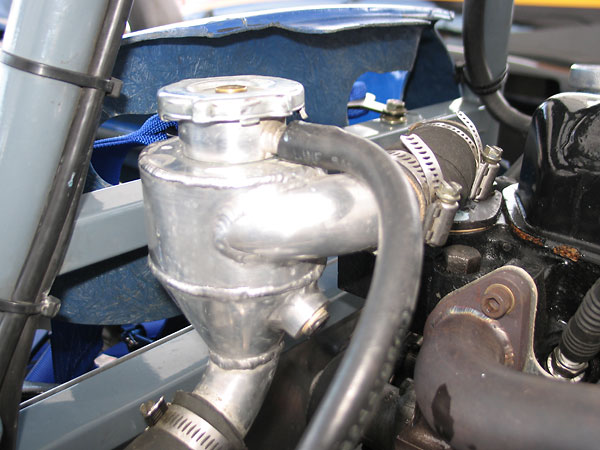
�
Swirling of coolant within this custom fabricated aluminum tank helps seperate out air bubbles.
�
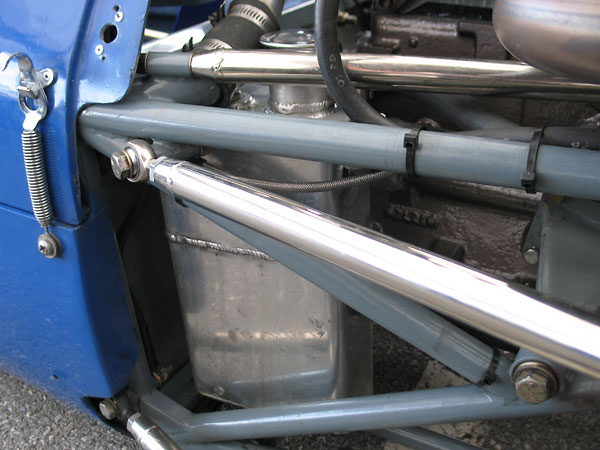
�
Custom fabricated aluminum oil reservoir.
�
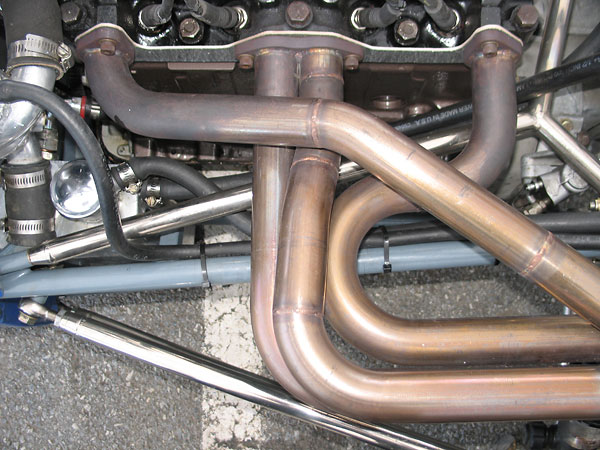
�
Four into one stainless steel header.
�
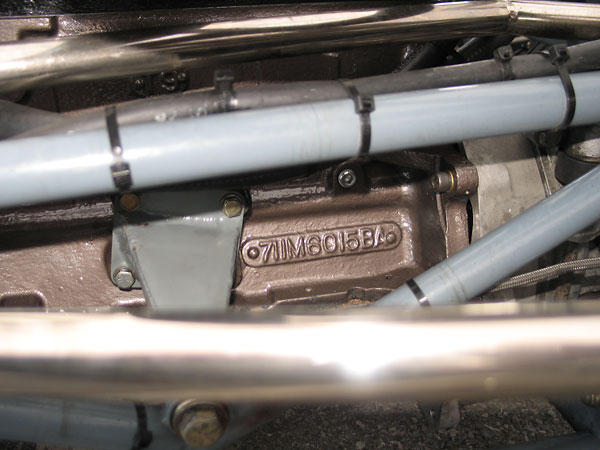
�
Replacement 711M6015BA engine block; this is a 1600cc "tall" block with big bearing caps.
�
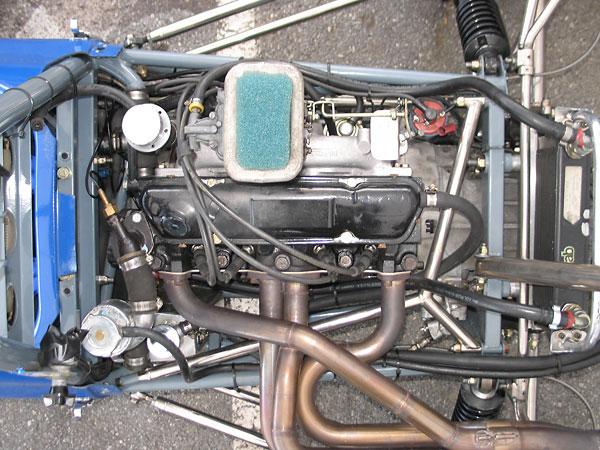
�
The enduring success of Formula Ford over so many years is largely based on how economically
�
and reliably the Ford "Kent" engine performs. It has helped to provide a level playing field.
�
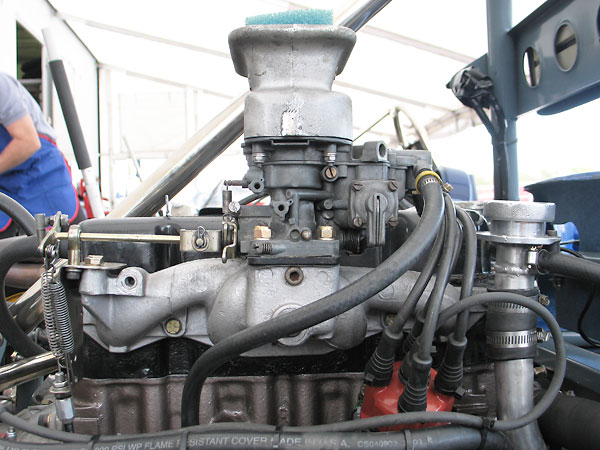
�
Weber 32/36 DGV carburetor.
�
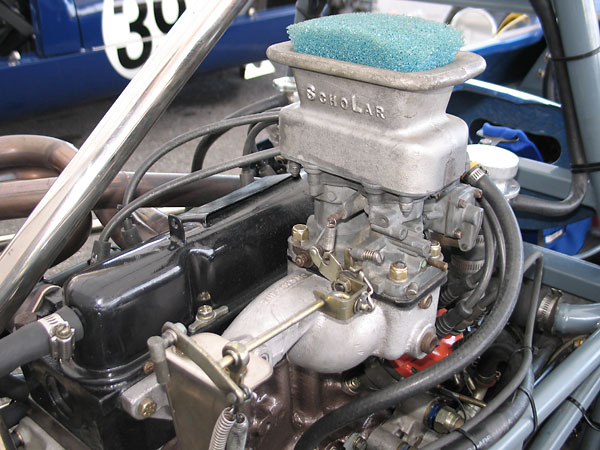
�
Original period SchoLar air inlet.
�
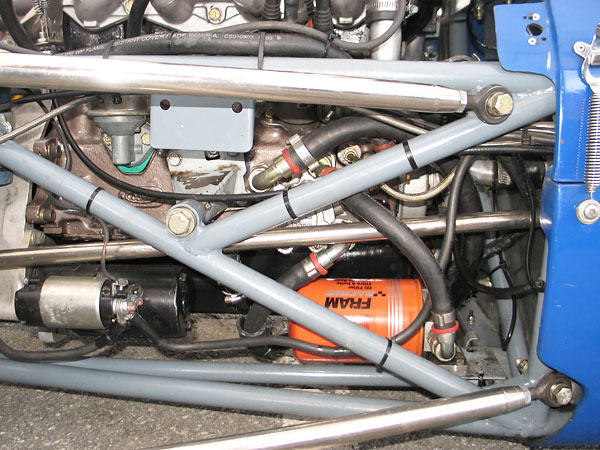
�
BSP barbed hose ends with high-temperature textile reinforced hose secured by Oetiker clamps.
�
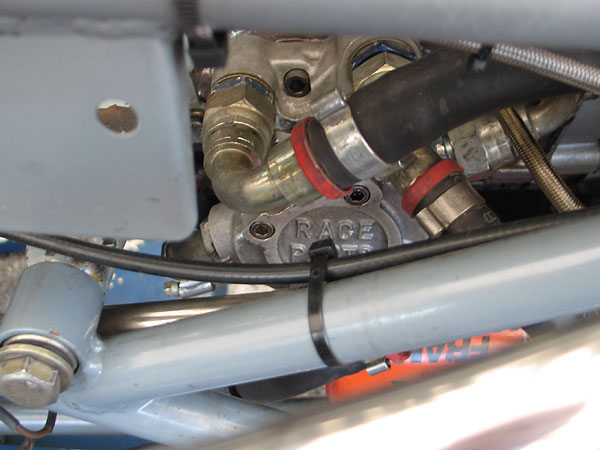
�
Race Parts oil pump cover.
�
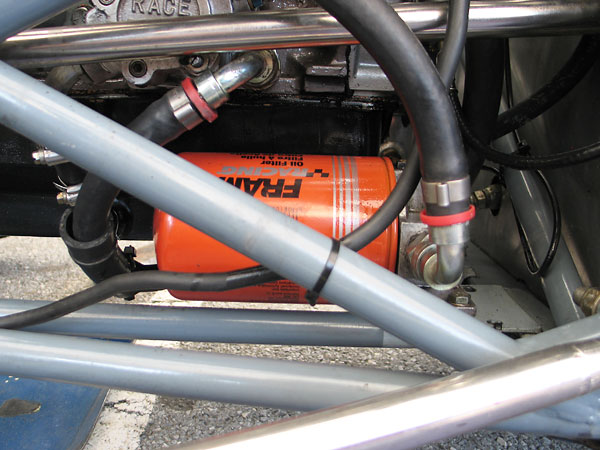
�
Fram Racing oil filter.
�
�
Front Suspension
��
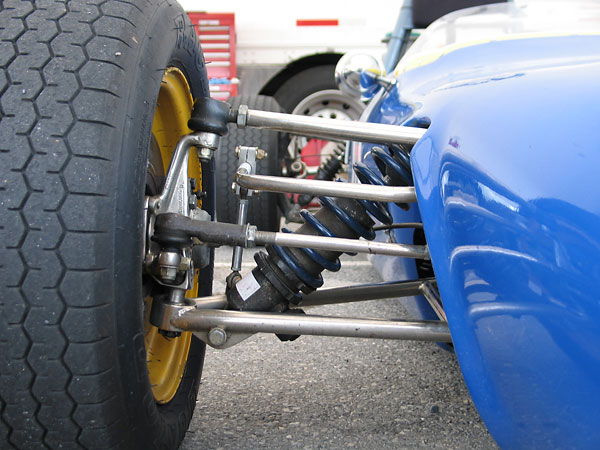
�
Unequal length wide-based wishbones. (These are new replacements installed during the last restoration).
�
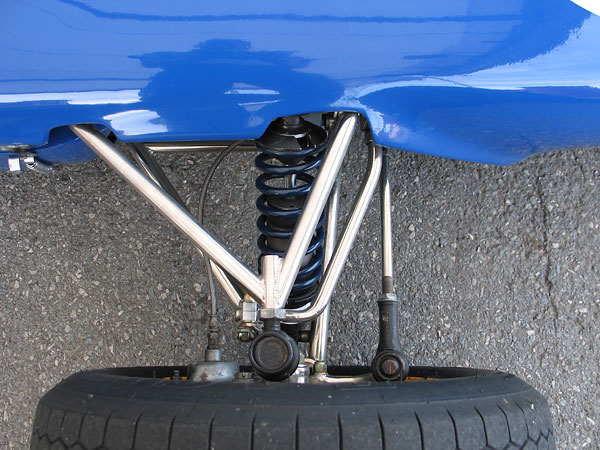
�
In two places, street-car style sealed tie rod ends have been installed where we usually expect to see
�
Heim joints (a.k.a. "Rose joints" or spherical rod ends.)
�
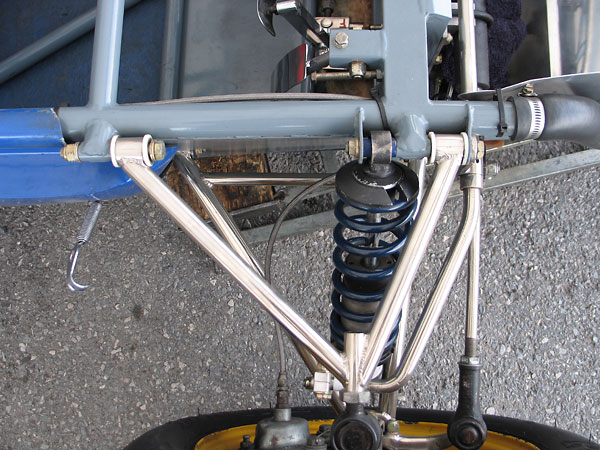
�
In such a competitive class, fine tuning of suspension geometry and alignment is important.
�
With fixed-length control arms as on the Merlyn 11A, fine tuning is at least very difficult
�
if not impossible. Heim joints that thread in or out would solve the problem. This car isn't
�
completely original though. The control arms have Nylon bushings instead of rubber bushes.
�
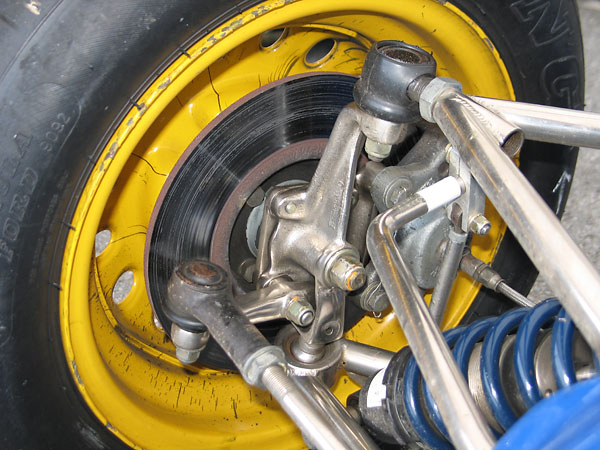
�
Triumph (Alford & Alder) forged uprights - just like pretty much every other Formula Ford of its era.
�
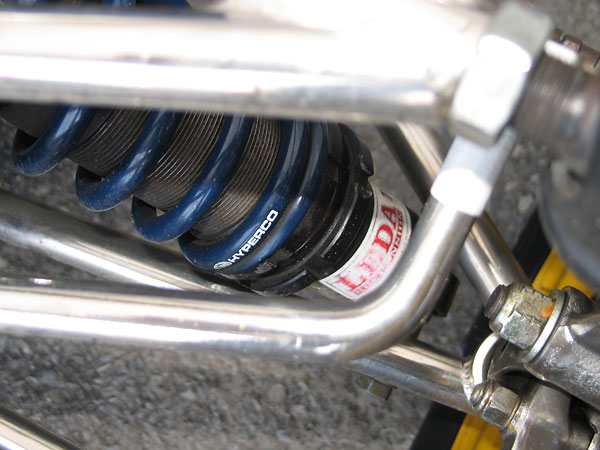
�
New Leda shocks (Armstrong replicas). Hyperco springs.
�
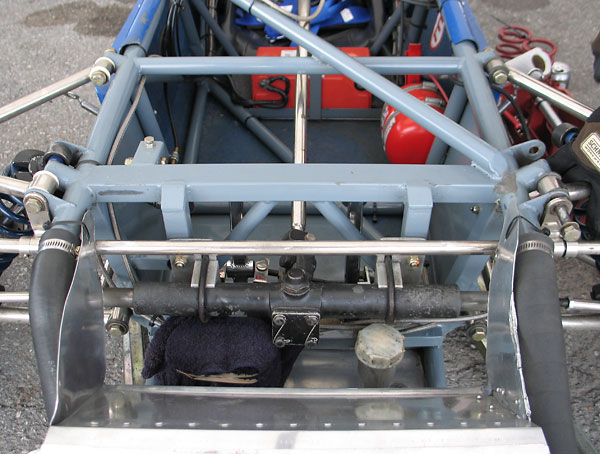
�
Interestingly, the steering rack is mounted on two u-bolts.
�
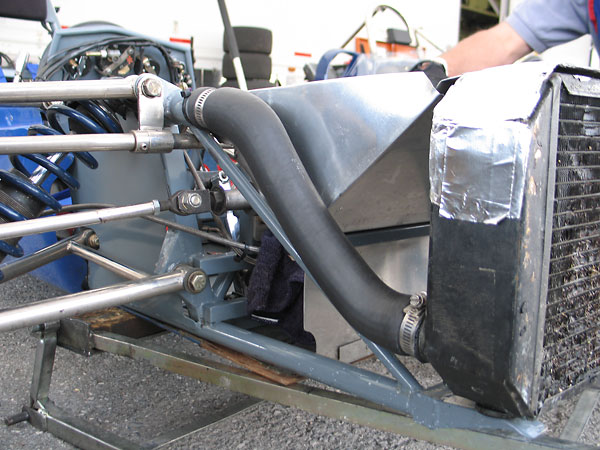
�
As original, engine coolant is plumbed through the frame. Most vintage Formula Ford owners have rerouted
�
coolant flow through external pipes for a variety of reasons: a cooler and more comforter driver compartment,
�
reduced corrosion and erosion issues, and the possibly reduced danger in the event of a severe shunt.
�
�
Enjoying this article? www.BritishRaceCar.com is partially funded through generous support from readers like you!
�
To contribute to our operating budget, please click here and follow the instructions.
�
(Suggested contribution is twenty bucks per year. Feel free to give more!)�
Rear Suspension
��
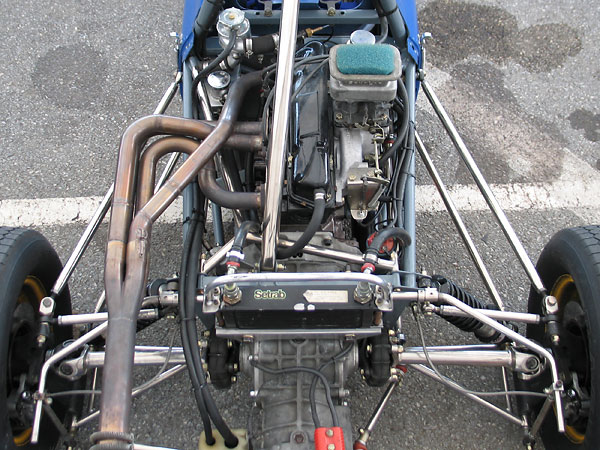
�
Inverted lower wishbones, single top links, and twin adjustable trailing links.
�
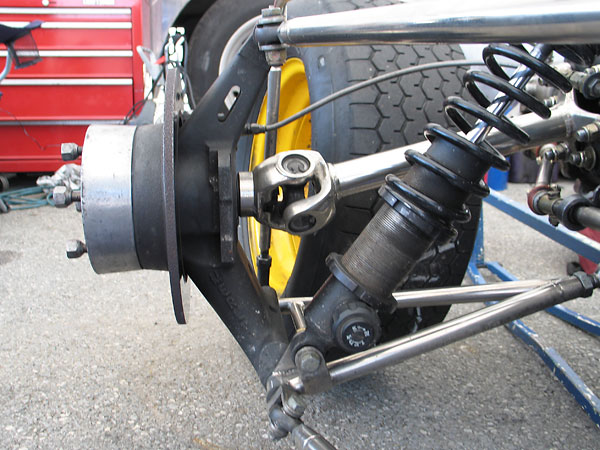
�
These are Leda single-adjustable shocks. Turn the valve clockwise for hard, counter-clockwise for soft.
�
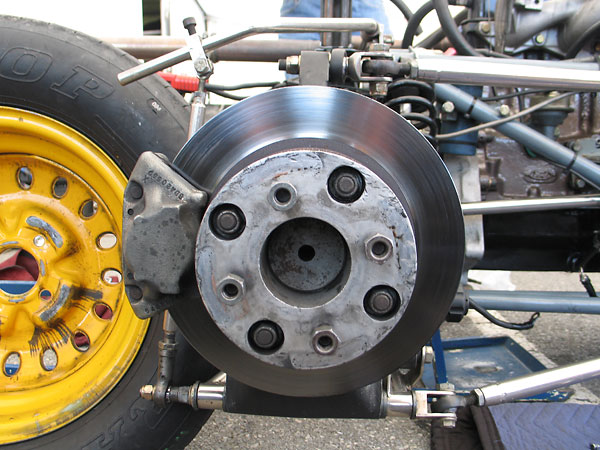
�
Adjustable rear anti-sway bar.
�
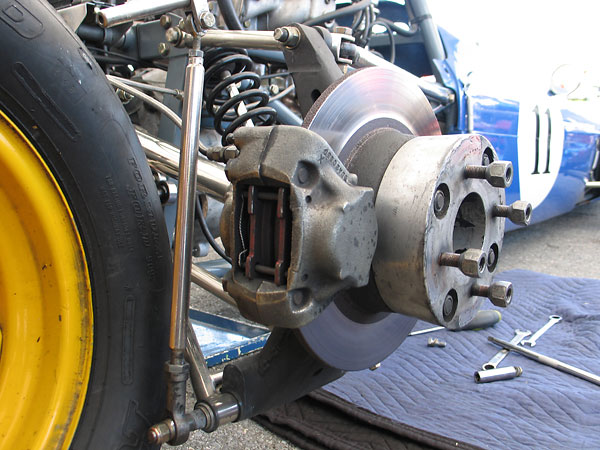
�
Thick aluminum hub spacers.
�
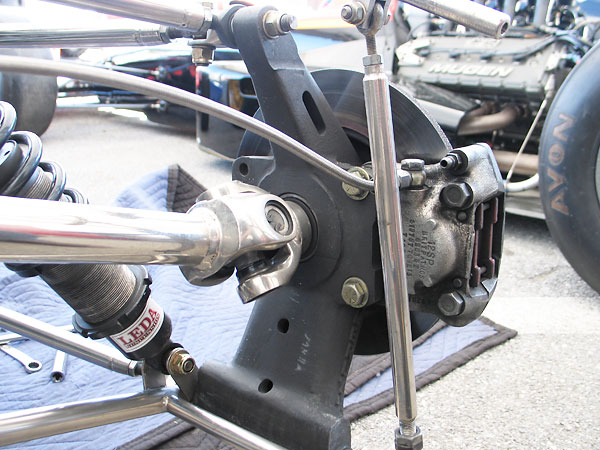
�
Girling 12SP brake caliper.
�
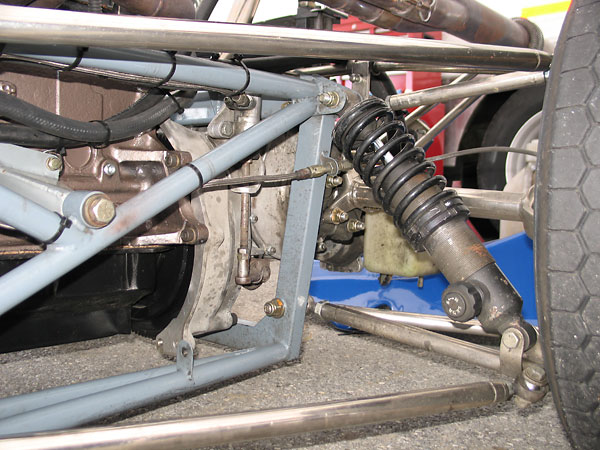
�
Girling clutch slave cylinder.
�
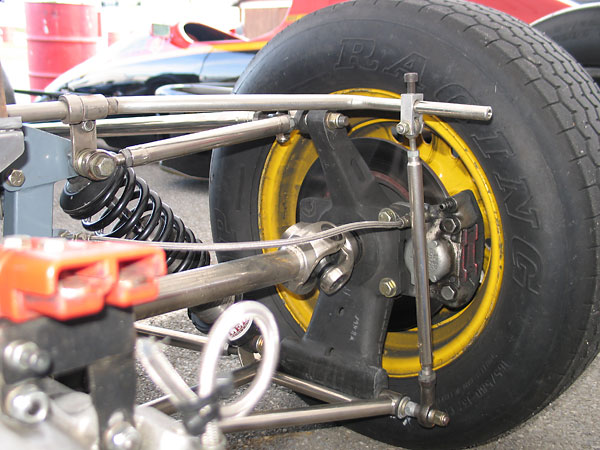
�
Proprietary Merlyn magnesium uprights.
�
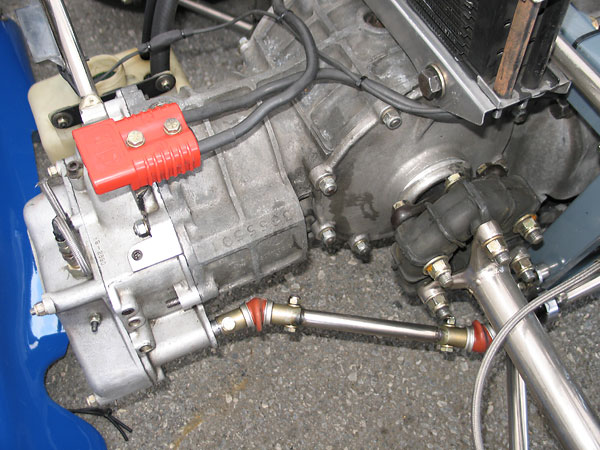
�
Bernard reports that his transaxle was rebuilt in 2010 with a Rhino gearbox case in lieu of the original
�
Volkswagen casting - after this photo was taken! Rhino cases are made in Brazil, not Germany. They have
�
heavier external ribbing from the differential housing back, and thus are stiffer. However the bellhousing
�
section is unchanged, and that's where cases usually crack. Rhino cases are recommended when "Mk"
�
Hewlands are used in higher horsepower applications. They're probably overkill for Formula Ford.
�
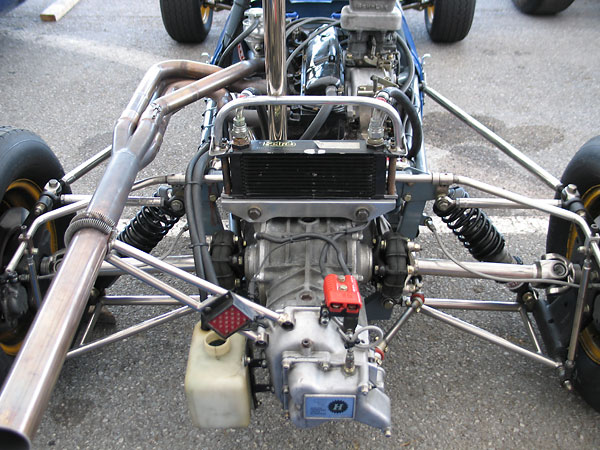
�
Setrab 13-row oil cooler (part# 50 613 7612).
�
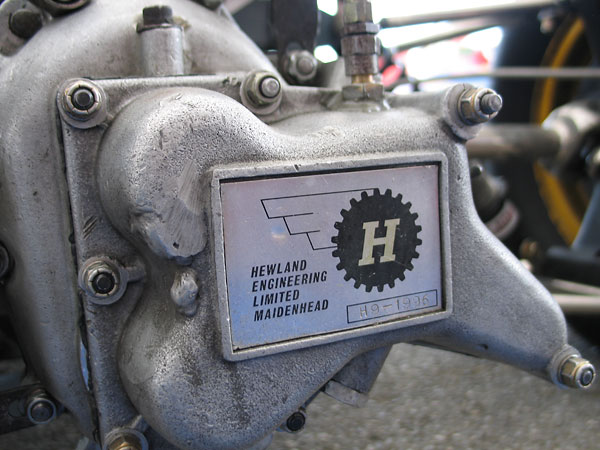
�
Hewland Engineering Ltd., Maidenhead: H9-1996
�
�
Interior
��
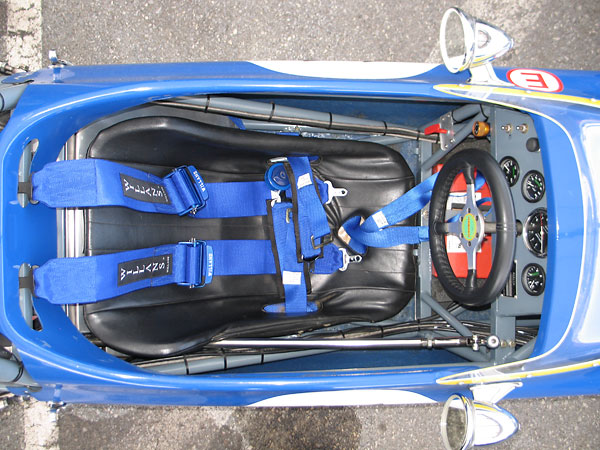
�
Willans six point Cam-loc safety harness (expires end of 2014).
�
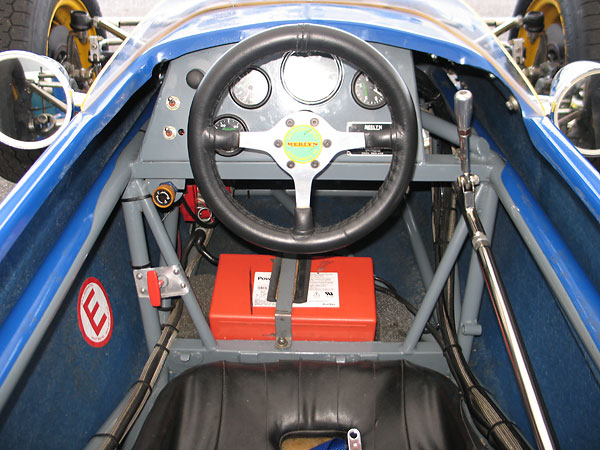
�
Enersys Powersafe SBS sealed battery.
�
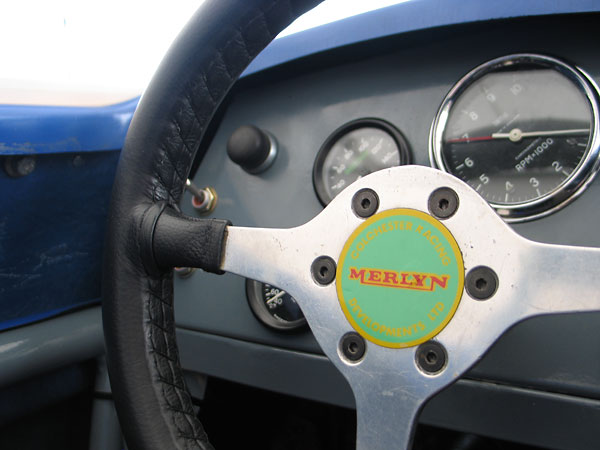
�
(left to right) Racetech oil temperature gauge (40-140C) and oil pressure (0-160psi) gauge.
�
Original Smiths chronometric tach (0-10,000rpm). Racetech coolant temperature (30-110C) gauge.
�
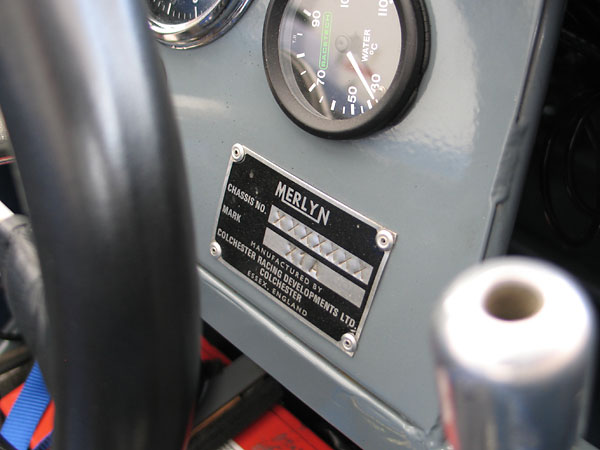
�
Chassis number XXXXXXX? Evidently the original chassis plate was been lost. Bernard Bradpiece possesses
�
a signed statement from Clive Hatward of CRD that this is indeed an original Merlyn 11A chassis.
�
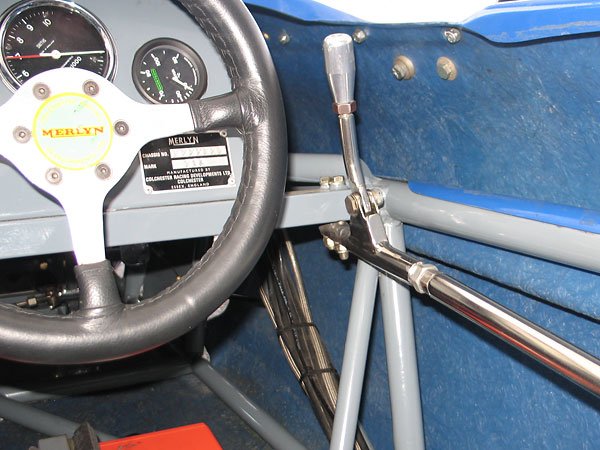
�
This gear selector mechanism puts the shift knob further forward and higher than most Formula Fords.
�
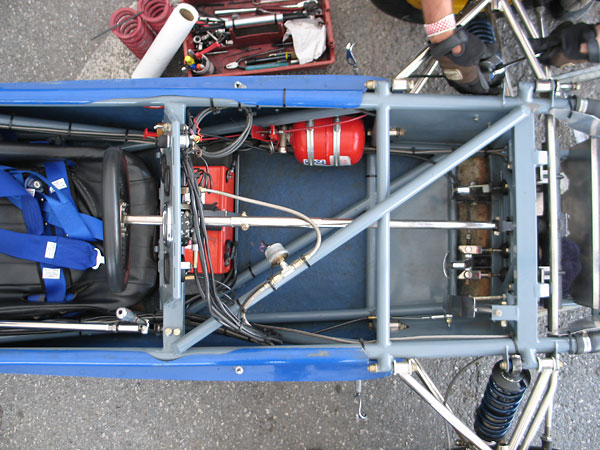
�
An especially interesting chassis detail: steel panels on both sides of the footbox as well as
�
underneath the driver's heels. The balance of the car's floor is fiberglass.
�
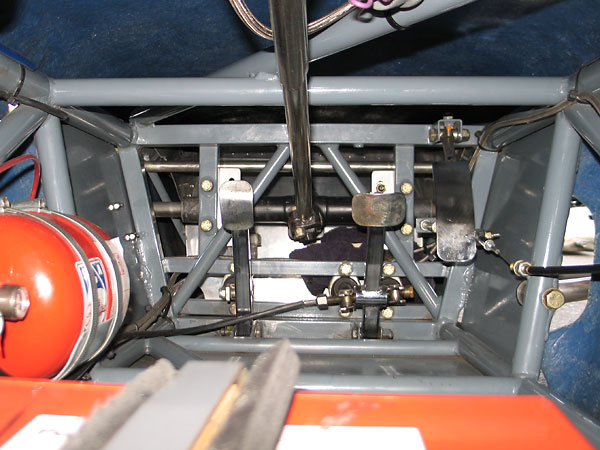
�
Any sort of bulkhead between pedal box and master cylinders is missing on this particular Merlyn 11A.
�
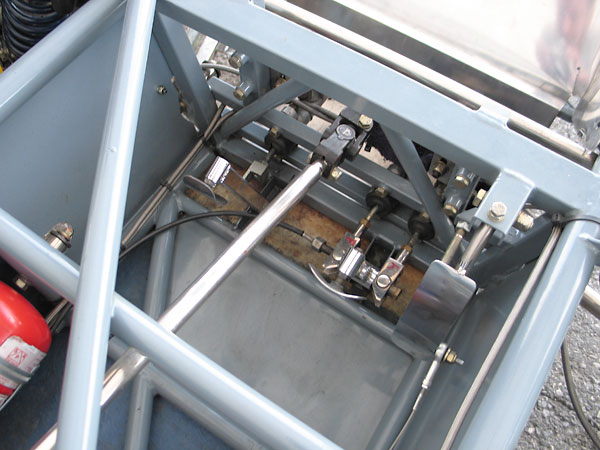
�
Front to rear brake balance is adjustable by rotating a knob just below the dashboard. In this view we
�
see the remote control cable, and how it routes to the bias bar between dual Girling master cylinders.
�
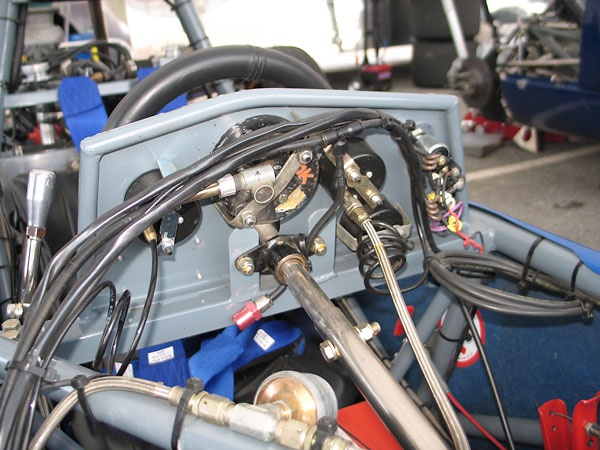
�
How Merlyn constructed their distinctive steel instrument panel.
�
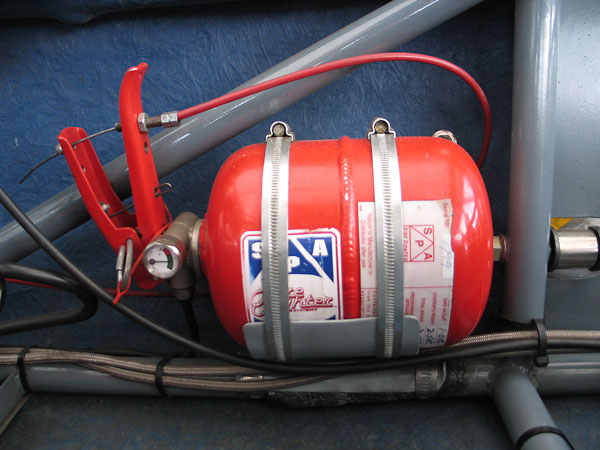
�
S.P.A. Fire Fighter centralized fire suppression system.
�
�
Exterior
��
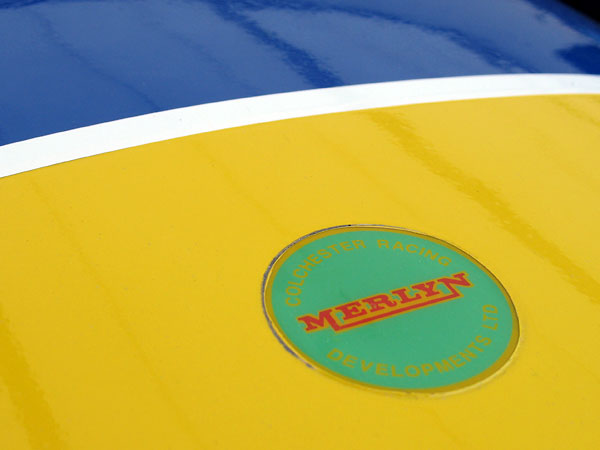
�
Merlyn - Colchester Racing Developments Ltd.
�
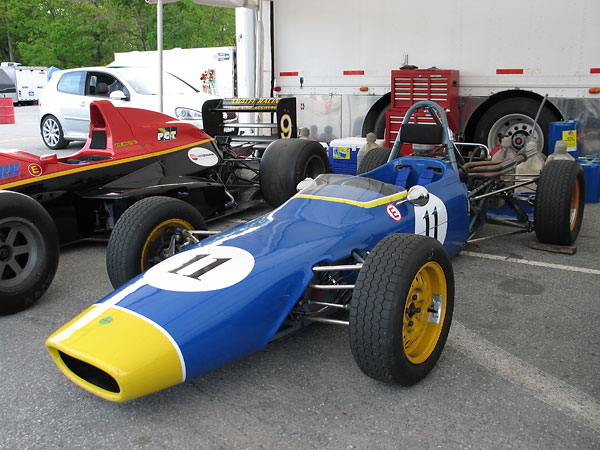
�
The brilliant blue color of this car isn't paint. That's the original tinted gelcoat!
�
(Gelcoat is a thin layer of resin that's applied to the mold before the fiberglass
�
fabricator starts laying in layers of resin impregnated fiberglass mat or fabric.)
�
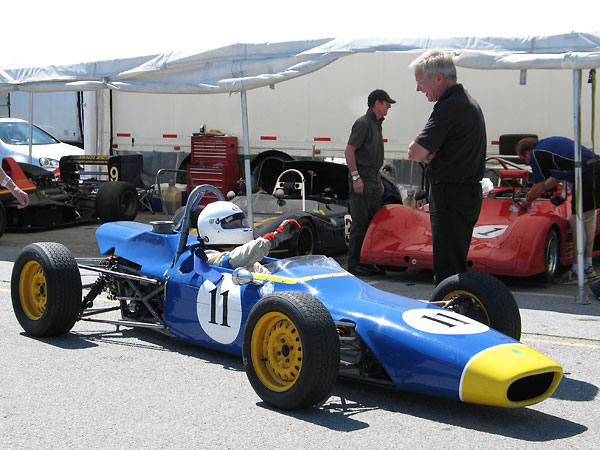
�
In the background here you can glimpse Bernard's other racecar: a lovely blue Elva MkVII.
�
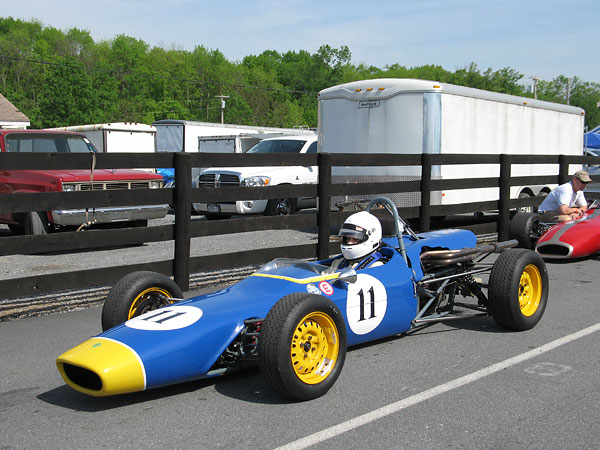
�
Formula Ford rules have always disallowed wings. Formula Continental, Formula Atlantic, and Super Vee
�
racecars have used similar chassis, but with downforce producing wings as well as more powerful engines.
�
In comparison, Formula Ford drivers have to corner especially smoothly to minimize losses of momentum.
�
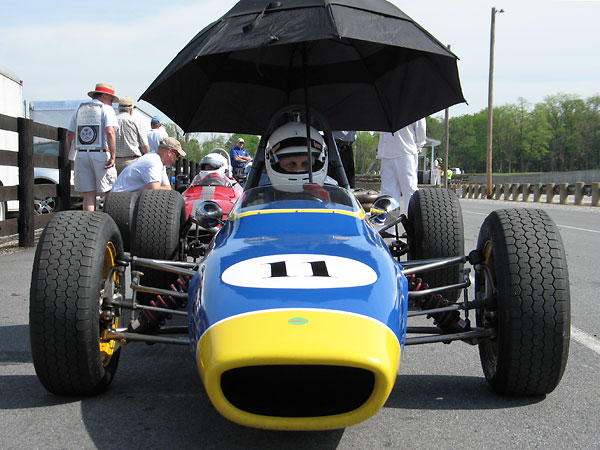
�
One of the reasons Bernard Bradpiece especially loves the Merlyn 11A is it features a
�
longer wheelbase than some vintage Formula Ford rivals.
�
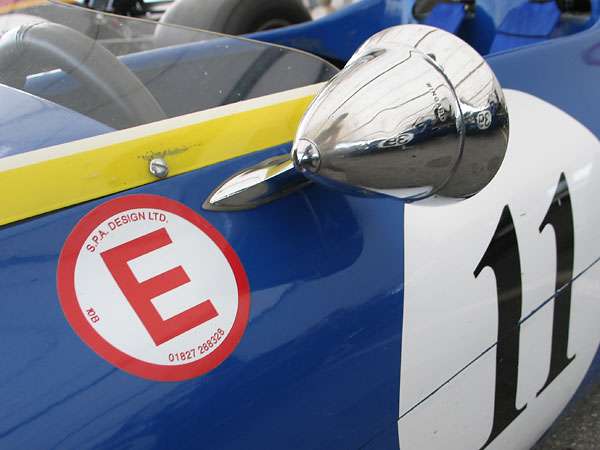
�
Vintage Wingard mirror.
�
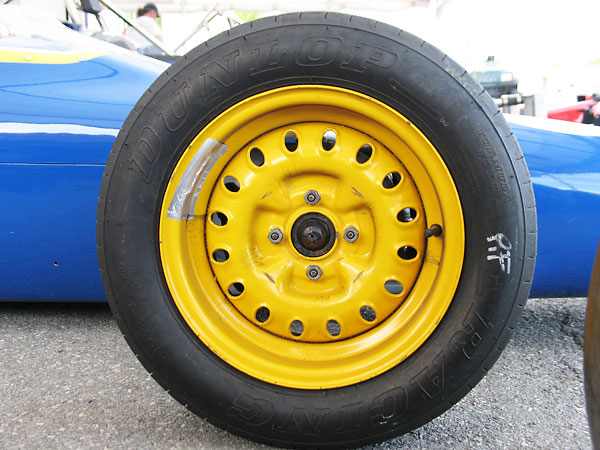
�
Early Weller type steel wheels.
�
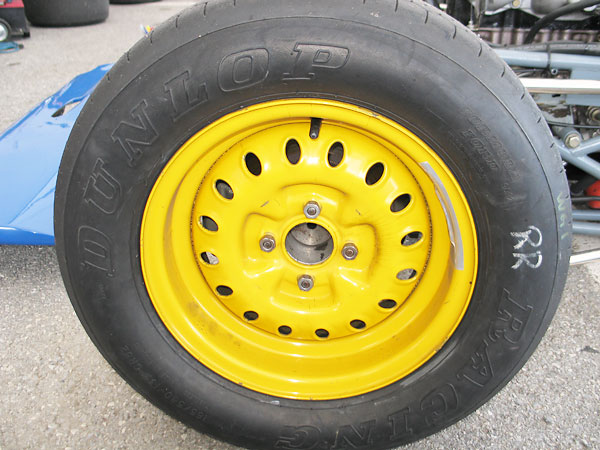
�
Dunlop Racing "Formula Ford" tires (135/545-13 CR82 front, 165/580-13 CR82 rear).
�
�
All photos shown here are from April 2010 when we viewed the car at VRG's Jefferson 500�
at Summit Point Motorsports Park, West Virginia. Photos by Curtis Jacobson for BritishRaceCar.com, �
copyright 2010. All rights reserved.
�
| If you liked this article, you'll probably also enjoy these: | �|||||
 | �
Dave Fairchild 1969 Merlyn 11A | �
 | �
Scott Fairchild 1972 Royale RP3A | �
 | �
Gord Leach 1974 Hawke DL11 | �
| You're invited to discuss anything you've seen here on The British Racecar Motorsports Forum! | �|||||
�
Notice: all the articles and almost all the photos on BritishRacecar.com are by Curtis Jacobson.
�
(Photos that aren't by Curtis are explicitly credited.) Reproduction without prior written permission is prohibited.
�
Contact us to purchase images or reproduction permission. Higher resolution images are optionally available.
�

 �
�